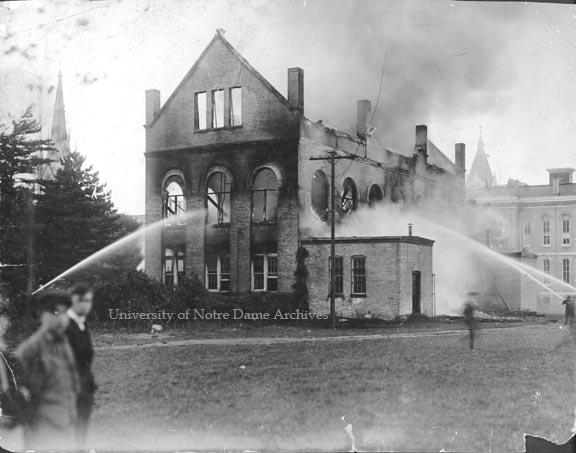
The building now known as Crowley Hall originally housed the Institute of Technology, which comprised of the following departments: Theoretical and Experimental Engineering, Practical Mechanics, and Machine Drawing and Design. The University Architect’s Building Inventory lists Fr. John Zahm, CSC, and Brother Charles Harding, CSC, as principle architects. It is one of many examples of buildings on campus that have held a number of different functions over the years.

The 1892-1893 prospectus bulletin stated that “[t]his building has been erected on the most approved plans, after a study of the best institutions of the kind at home and abroad.” The 1893-1894 bulletin boasted that it was “a large and commodious building, devoted to the use of the students of civil, mechanical, and electrical engineering. It is fully equipped with all the appliances for wood and metal working, and is supplied with the most approved forms of forges and cupolas for blacksmithing and foundry work. The rooms for mechanical drawing, and the laboratories for special experimental work in mechanical engineering are used, and are complete in all their appointments.”
In 1907, the Chemistry department settled into this building, which would then be dubbed “Chemistry Hall.” The Pharmacy Department had laboratories on the second floor.


On September 13, 1916, fire broke out in the phosphorus collection on the third floor, injuring a number of firemen, students, and spectators. With all the different chemicals and potential reactions in the building, the firemen had to use a different approach than water, which was only making matters worse. They used wet sand to extinguish the phosphorus fire and the South Bend firefighters left the scene eight hours later, saving the lower two floors.

A week later, however, some of the remaining phosphorous again ignited and continued to ravage the building, sending dangerous sparks as far away as St. Edward’s Hall. This occurred when class was being held in the already charred building. The building and its contents were pretty much destroyed, except for a small addition on the northeast corner, which remained untouched by the fire.

Chemistry Hall, destroyed by fire, is in the background
The cornerstone for new Chemistry Hall was laid at the 1917 commencement extercises and is now the Riley Hall of Art and Design. Nieuwland Hall was built in 1952 as a new facility for the Chemistry Department. Chemistry also has space in Stepan Chemistry Hall, which was completed in 1982 with an addition in 2002.
But the story of this 1893 building does not end with the fire. Notre Dame restored the building, which became Hoynes Hall, the home of the Law School until the Law School Building was completed in 1931. Later it housed the Architecture Department and Psychology Department, and it has been the home of the Music Department since 1976. It was named for Patrick F. Crowley, who founded the Christian Family Movement (CFM) with his wife Patricia. They were named Laetare Medalists in 1966. Crowley’s brother-in-law John Caron made the gift to the University in Crowley’s name. The Architecture Department moved to Lemonnier Library (now Bond Hall) when the Hesburgh Library opened in 1963. The Psychology Department moved to Haggar Hall in 1974.

Sources:
Scholastic
PNDP 10-Ch-1
PNDP 10-Cr-1
PNDP 30-Bu-02: 1892-1894 Bulletins
GGPP 02/01
GNDL 30/30
GNDS 03/04
GNIE
GTJS

There is a minor branch of history of which most people are unaware — the history of things that never happened. I can contribute a small chapter to this branch of history.
When I was Vice President for Graduate Studies and Research, and Dean of the Graduate School (1996-2001), I brought forward to the university authorities a plan to convert Crowley Hall to a Graduate Student Center, similar to Dudley House at Harvard (1) and similar centers at other eminent universities. The proposal was originated by my close colleague and friend, Associate Vice President Tony Hyder. It included detailed plans for various meeting venues and facilities that would bring together graduate students from many different disciplines to provide them with an enriching intellectual atmosphere while immersed in the highly-focussed discipline of writing a Ph.D. dissertation. Plans were underway for the DeBartolo Performing Arts Center, and it was widely believed that the music department would move from Crowley to DPAC. To my chagrin, this proposal had few supporters, and emerged stillborn, never seeing the light of day. The music department still occupies Crowley Hall.
(1) Dudley House, The Graduate Student Center
Dudley House is where the GSAS community comes together for socials, meals, lectures, and other events. Located in Harvard Yard and about a ten-minute walk from the residence halls, Dudley House serves the extracurricular needs of students in the Graduate School of Arts and Sciences. Services and facilities include Cafe Gato Rojo, a dining hall, meeting space for student organizations and teaching fellows, computer/printing facilities, a library/reading room, a game room, and lockers. Of special note, GSAS students who serve as Dudley House Fellows plan activities throughout the academic year, including lectures, dinners, dances, social events, movies, films, theatre, and music.
For more information, please visit the Dudley House webpage.